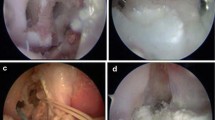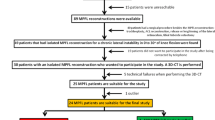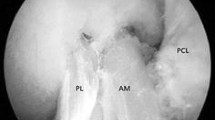Abstract
The issue of the best place to attach an anterior cruciate ligament graft to the femur is controversial, and different anatomic or isometric points have been recommended. It was hypothesised that one attachment site could be identified that would be best for restoring normal anterior–posterior laxity throughout the range of knee flexion. It was also hypothesised that these different attachment sites would cause different graft tension patterns during knee flexion. Using six cadaver knees, an isometric point was found 3 mm distal to the posterior edge of Blumensaat’s line, at the 10:30–11:00 o’clock position in right knees, at the antero-proximal edge of the anatomic ACL attachment. Anterior–posterior laxity was measured at ±150 N draw force at 20–120° flexion with the knee intact and after anterior cruciate ligament transection. The graft was placed at the isometric point, and AP laxity was restored to normal at 20° flexion, then measured at other angles. Graft tension was measured throughout, and also during passive flexion–extension. This was repeated for four other graft positions around the isometric point in every knee. Laxity was restored best by grafts tensioned to a mean of 9±14 N, positioned isometrically and 3 mm posterior to the isometric point. Their tension remained low until terminal extension. Grafts 3 mm anterior to the isometric point caused significant overconstraint, and had higher tension beyond 80° knee flexion. Small changes in attachment site had large effects on laxity and tension patterns. These results support an isometric/posterior anatomic femoral graft attachment, which restored knee laxity to normal from 20 to 120° flexion and did not induce high graft tension as the knee flexed. Grafts attached to the roof of the intercondylar notch caused overconstraint and higher tension in the flexed knee.




Similar content being viewed by others
References
Abrahams M (1967) Mechanical behaviour of tendon in vitro. Med Biol Eng 5:433–443
Amis AA (1989) Anterior cruciate ligament replacement: knee stability and the effects of implants. J Bone Joint Surg Br 71:819–824
Amis AA, Dawkins GPC (1991) Functional anatomy of the anterior cruciate ligament—fibre bundle actions related to ligament replacements and injuries. J Bone Joint Surg Br 73:260–267
Amis AA, Jakob RP (1998) Anterior cruciate ligament graft positioning, tensioning and twisting. Knee Surg Sports Traumatol Arthrosc 6(Suppl 1):S2–S12
Amis AA, Scammell BE (1993) Biomechanics of intra-articular and extra-articular reconstructions of the anterior cruciate ligament. J Bone Joint Surg Br 75:812–817
Amis AA, Zavras TD (1995) Review article: isometricity and graft placement during anterior cruciate ligament reconstruction. Knee 2:5–17
Andersen HN, Amis AA (1994) Review on tension in the natural and reconstructed anterior cruciate ligament. Knee Surg Sports Traumatol Arthrosc 2:192–202
Bull AMJ, Andersen HN, Basso O, Targett J, Amis AA (1999) Incidence and mechanism of the pivot shift: an in vitro study. Clin Orthop 363:219–231
Butler DL, Noyes FR, Grood ES (1980) Ligamentous restraints to anterior–posterior drawer in the human knee: a biomechanical study. J Bone Joint Surg Am 62:259–270
Bylski-Austrow DI, Grood ES, Hefzy MS, Holden JP, Butler DL (1990) Anterior cruciate ligament replacements: a mechanical study of femoral attachment location, flexion angle at tensioning, and initial tension. J Orthop Res 8:522–531
Daniel DM, Stone ML (1990) KT-1000 anterior–posterior displacement measurements. In: Daniel D, Akeson W, O’Connor J (eds) Knee ligaments: structure, function, injury and repair. Raven, New York, pp 427–447
Drillis R, Contini R (1966) Body segment parameters. Technical report 1166.03, New York University
Fleming B, Beynnon B, Howe J, McLeod W, Pope M (1992) Effect of tension and placement of a prosthetic anterior cruciate ligament on the anteroposterior laxity of the knee. J Orthop Res 10:177–186
Fleming B, Beynnon BD, Johnson J, McLeod WD, Pope MH (1993) Isometric versus tension measurements. Am J Sports Med 21:82–88
Friederich NF, Muller W (1993) How important is isometric placement of cruciate ligament grafts? Intraoperative measurement vs mid-term clinical follow-up. J Bone Joint Surg Br 75(Orthop Proc - Suppl 2):150–151
Friederich NF, O’Brien WR (1992) Functional anatomy of the cruciate ligaments. In: Jakob RP, Staubli HU (eds) The knee and the cruciate ligaments. Springer, Berlin Heidelberg New York, pp 78–91
Friederich NF, Muller W, O’Brien WR (1992) Klinische Anwendung biomechanischer und funkionell anatomischer Daten am Kniegelenk. (Clinical application of biomechanic and functional anatomical findings of the knee joint). Orthopade 21:41–50
Harner CD, Fu FH, Irrgang JJ, Vogrin TM (2001) Anterior and posterior cruciate ligament reconstruction in the new millennium: a global perspective. Knee Surg Sports Traumatol Arthrosc 9:330–336
Harries WJ, Amis AA (1995) The Apex polyester fibre anterior cruciate ligament implant: operative procedure and early results. Knee 1:209–215
Hefti F, Drobny T, Hackenbruch W et al (1990) Evaluation of knee ligament injuries: the OAK and IKDC forms. In: Jakob RP, Staubli HU (eds) The knee and the cruciate ligaments. Springer, Berlin Heidelberg New York, pp 134–139
Hefzy MS, Grood ES, Noyes FR (1989) Factors affecting the region of most isometric femoral attachments. Part II: the anterior cruciate ligament. Am J Sports Med 17:208–216
Hoogland T, Hillen B (1984) Intra-articular reconstruction of the anterior cruciate ligament: an experimental study of length changes in different ligament reconstructions. Clin Orthop 185:197–202
Howell SM, Taylor MA (1998) Failure of reconstruction of the anterior cruciate ligament due to impingement by the intercondylar roof. J Bone Joint Surg Am 75:1044–1055
Kohn D, Busche T, Carls J (1998) Drill hole position in endoscopic anterior cruciate ligament reconstruction: results of an advanced arthoroscopy course. Knee Surg Sports Traumatol Arthrosc 6(suppl 1):S13-S15
Kurosawa H, Yamakoshi KI, Yasuda K, Sasaki T (1991) Simultaneous measurement of changes in length of the cruciate ligaments during knee motion. Clin Orthop 265:233–240
Markolf KL, Hame S, Hunter M, Oakes DA, Zoric B, Gause P, Finerman GAM (2002) Effects of femoral tunnel placement on knee laxity and forces in an anterior cruciate ligament graft. J Orthop Res 20:1016–1024
Melhorn MJ, Henning CE (1987) The relationship of the femoral attachment site to the isometric tracking of the anterior cruciate ligament graft. Am J Sports Med 15:539–542
O’Meara PM, O’Brien WR, Henning CE (1992) Anterior cruciate ligament reconstruction stability with continuous passive motion. Clin Orthop 277:201–209
Penner DA, Daniel DM, Wood P, Mishra D (1988) An in vitro study of anterior cruciate ligament graft placement and isometry. Am J Sports Med 16:238–243
Piziali RL, Rastegar J, Nagel DA, Schurman DJ (1980) The contribution of the cruciate ligaments to the load–displacement characteristics of the human knee joint. J Biomech Eng 102:277–283
Race A, Amis AA (1998) PCL reconstruction: in vitro biomechanical comparison of “isometric” versus single and double-bundled “anatomic” grafts. J Bone Joint Surg Br 80:173–179
Sapega AA, Moyer RA, Schneck C, Komalahiranya N (1990) Testing for isometry during reconstruction of the anterior cruciate ligament. J Bone Joint Surg Am 72:259–267
Sidles JA, Larson RV, Garbini JL, Downey DJ, Matsen FA (1988) Ligament length relationships in the moving knee. J Orthop Res 6:583–610
Simmons R, Howell SM, Hull ML (2003) Effect of the angle of the femoral and tibial tunnels in the coronal plane and incremental excision of the posterior cruciate ligament on tension of an anterior cruciate ligament graft: an in vitro study. J Bone Joint Surg Am 85(A6):1018–1029
Uh BS, Beynnon BD, Johnson RJ, Fleming BC, Renstron PA, Nichols CE (1998) The elongation behavior of the anterior cruciate ligament graft in-vivo: a long-term follow-up study. In: Proceedings of the 44th Annual Meeting of the Orthopedic Research Society, p 69
Wallace MP, Howell SM, Hull ML (1997) In vivo tensile behavior of a four-bundle hamstring graft as a replacement for the anterior cruciate ligament. J Orthop Res 15:539–545
Woo SL-Y, Hollis JM, Adams DJ, Lyon RM, Takai S (1991) Tensile properties of the human femur-anterior cruciate ligament-tibia complex: the effects of specimen age and orientation. Am J Sports Med 19:217–225
Zavras TD, Amis AA (1998) Method for visualising and measuring the position of the femoral attachment of the ACL and ACL grafts in experimental work. J Biomech 31:387–390
Zavras TD, Race A, Bull AMJ, Amis AA (2001) A comparative study of isometric points for ACL reconstruction. Knee Surg Sports Traumatol Arthrosc 9:28–33
Acknowledgements
This work was funded by the Arthritis Research Campaign, a charity based in Chesterfield, England. The protocol was developed with assistance from Mr. Anil Rekraj, M.Sc. student. We also thank Mr. Kevin Pickett for his technical assistance.
Author information
Authors and Affiliations
Corresponding author
Rights and permissions
About this article
Cite this article
Zavras, T.D., Race, A. & Amis, A.A. The effect of femoral attachment location on anterior cruciate ligament reconstruction: graft tension patterns and restoration of normal anterior–posterior laxity patterns. Knee Surg Sports Traumatol Arthrosc 13, 92–100 (2005). https://doi.org/10.1007/s00167-004-0541-5
Received:
Accepted:
Published:
Issue Date:
DOI: https://doi.org/10.1007/s00167-004-0541-5




